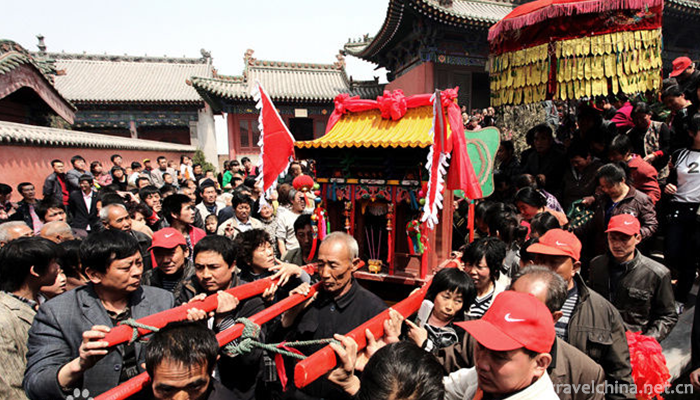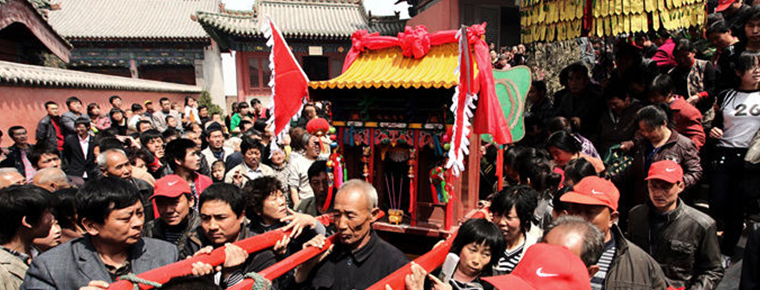Hongdongs custom of visiting relatives
Hongdongs custom of visiting relatives
The custom of walking relatives in Hongdong is a kind of Han traditional folk culture which spreads in Ganting, Wucun, Xincun, Longma and Wanan townships in Hongdong County and Yaodu District of Linfen City, Shanxi Province. It involves more than 20 villages and crosses the East and West banks of the Fenhe River. The local Han people are known as "going to relatives on March 3rd" and "taking aunts to meet their mothers", which are related to the legend of the marriage relationship between Emperor Yao's daughter "Nv Ying" and Shun. The first batch and the second batch of national intangible cultural heritage in Shanxi Province.
historical origin
As an ancient folk culture of the Han nationality, Hongdong's family-walking activities span five townships, Ganting, Wucun, Xincun, Longma and Wan'an, in two counties (districts) of Linfen City, Shanxi Province. They involve more than 20 villages and cross the East and West banks of the Fenhe River, with a wide range of influence.
There is a local legend about the activity of "receiving aunts and welcoming mothers" to visit relatives. The original name of the village is Zhoufu Village. Later, a ewe gave birth to a one-horned sheep. Its name is "Mao", which is a divine beast and has the ability to distinguish good from evil. As the Road History says, "Sex knows straight, knows guilty, and can not touch straight." The matter was known to Gao Tao, the sage of Shishicun and the judicial officer of Yao, and reported to Emperor Yao. King Yao of Pingyang, Dingdu, came to visit with his pregnant wife. Unexpectedly, his wife gave birth to female Ying in the land where she was born. Yao saw that there were God beasts and saints and babies in this area. He moved to live with his whole family and renamed the village as a goat otter. Shun Geng Li Shan is a well-known story in ancient books. Although there are more than 20 places in the name of Li Shan in China, the local people firmly believe that Shun cultivates in this Li Shan. They are favored by the visiting sage King Yao and marry E Huang and Nv Ying to Shun. Therefore, Otter and Lishan are the mother-in-law's and mother-in-law's families of the two goddesses respectively. Owing to the relationship of generations, Otter people call them "aunt", and Lishan and other places call them "mother-in-law". Every year on March 3rd of the lunar calendar, near the Qingming Dynasty, it is the day of grave sweeping and ancestor sacrifice. The goats pick them up from the calendar mountain to their mother's home and their relatives until April 28th (the birthday of King Yao). The calendars come to pay homage to King Yao and take the two mothers back. Then they will enter the busy season of agriculture.
(Atlas 2 of Hongtong's Family Visiting Customs Activities)
cultural meaning
First of all, the ceremony and legend of visiting relatives are important ways for the working people of the Han nationality to remember together and oral records of the evolution of regional history. Legend has a function of explanation. When people tend to obscure and forget history, history gradually evolves into memory and enters people's minds. When handed down from generation to generation, it gradually forms rich Han folklore. The legend of Yao and Shun and the explanation of the origin of the village name obviously have the nature of this common memory, which is also a warning to future generations not to forget history.
Secondly, the custom and legend of visiting relatives maintain a regional social order. Wherever people go during the activity, they are enthusiastic and pious, conveying a kind of social ethics, morality and taboos. Eating "waist meal" and staying in the village after dark have realized the process and purpose of family recognition and highlighted their attachment to family relations, which has played an important role in strengthening regional ties, especially in this society where the sense of space is becoming stronger and the interpersonal relationship is becoming more and more tense. Such family-visiting ceremonies will undoubtedly give people a lot of inspiration, about interpersonal and living space. Between. In short, the March 3 visiting ceremony has become an important belief and recreational activity besides farming and living in southern Shanxi, which affects people's attitude to life, values and relatives. It is a kind act for people to actively participate in and respond to the busy farming. It is a way to express their beliefs and wishes. It is also a way to vent their emotions. It seeks spiritual sustenance in their personal efforts and experiences, realizes the harmony between relatives and neighbours, and maintains their friendship with foreigners.
Inheritance situation
According to textual research, the earliest record of existence can only be seen that Shun Temple existed in Lishan during the Northern Song Dynasty (see Shanxi Tongzhi Temple). Therefore, the custom of "receiving aunts and welcoming their wives" should originate around the Song Dynasty. However, local people, local intellectuals and even government officials all believe that this is the true history and believe that the whole "receiving aunts and welcoming their wives" is true. Family visits have also been handed down from the Yao and Shun times, with a history of four to five thousand years. They are extremely proud of this and defend their beliefs with practical actions. Even during the period when such activities were strictly prohibited during the "Cultural Revolution", they still took risks and dressed up to secretly pick up their aunts. Many people were detained and imprisoned for this reason.


-
1.Oyster omelet
Oyster fry is a common home dish, which originated in Quanzhou, Fujian Province, and is one of the classic traditional snacks in southern Fujian, Taiwan, Chaoshan and other regions.
Time 2018-11-02 -
2.Chengdu JinJiang Hotel
Jinjiang Hotel is the first five-star hotel in southwest China. It is located in Renmin South Road, the main road of Chengdu City, adjacent to the famous Funan River and echoes Tianfu Square
Time 2018-12-16 -
3.Bagong Mountain Tourist Scenic Area
Since 2001, Bagongshan Scenic Area has listed Bagongshan National Geopark, Bagongshan National Forest Park and Bagongshan National AAAA Tourist Area successively. Bagong Mountain is a famous historica
Time 2018-12-23 -
4.Xixi Wetland Tourist Area
Xixi National Wetland Park is located in the west of Hangzhou City, Zhejiang Province. It is only 6 kilometers away from Wulin Gate, the main city of Hangzhou, and 5 kilometers away from West Lake.
Time 2019-02-25 -
5.Xia Jin Old Yellow River Forest Park
The forest park scenic spot of the old Yellow River in Xiajin is the ruins of the old Yellow River. It is a national AAAA-level scenic spot. It is located in Xiajin County, Shandong Province
Time 2019-02-25 -
6.Ziweidong Scenic Area
Seeing the pronoun of the first reaction of "purple cave" to "immortal" cultivation and residence, we often enchase that fairyland dream on this name.
Time 2019-03-22 -
7.Caogao Gong and drum in northern Sichuan
Licao Gong and drum in northern Sichuan is a kind of traditional folk music. It mainly distributes in four counties and three districts of Guangyuan City, Sichuan Province
Time 2019-04-18 -
8.Daur traditional Hockey
Daur's traditional hockey sport is called "Bei Kuo Taj Ke Bei" in Daur language. Bei Kuo refers to a bat. The Daur bat is made by grinding oak wood with curved roots and straight branches. I
Time 2019-04-22 -
9.Han Embroidery
Han embroidery, one of the traditional embroidery techniques with Chinese characteristics, is based on Chu embroidery, which combines the merits of various
Time 2019-05-02 -
10.Huaibei Bangzi Opera
Huaibei Bangzi Opera originally named Shahe Diao, also known as Shahe Bangzi, Anhui Bangzi Opera, and Henan Henan Henan Opera belong to a different genre, is popular in Anhui Province
Time 2019-05-04 -
11.Cao Pi
Wei Wendi Cao Pi (187 - 26 June 29th) Zi Wan Pei Guo Qiao County, Yuzhou City (now Anhui Province Bozhou City People. Three Kingdoms period Famous Politician , Litterateur , the Wei state of the Three
Time 2019-09-15 -
12.Yi sea
The Yi sea is also known as the fish sea, and the local Yi people are called Su pin. It is located in Yangping mountain, Yihai Town, 40 km north of Mianning County. It is 330 km away from Chengdu, the capital of Sichuan Province
Time 2020-10-15